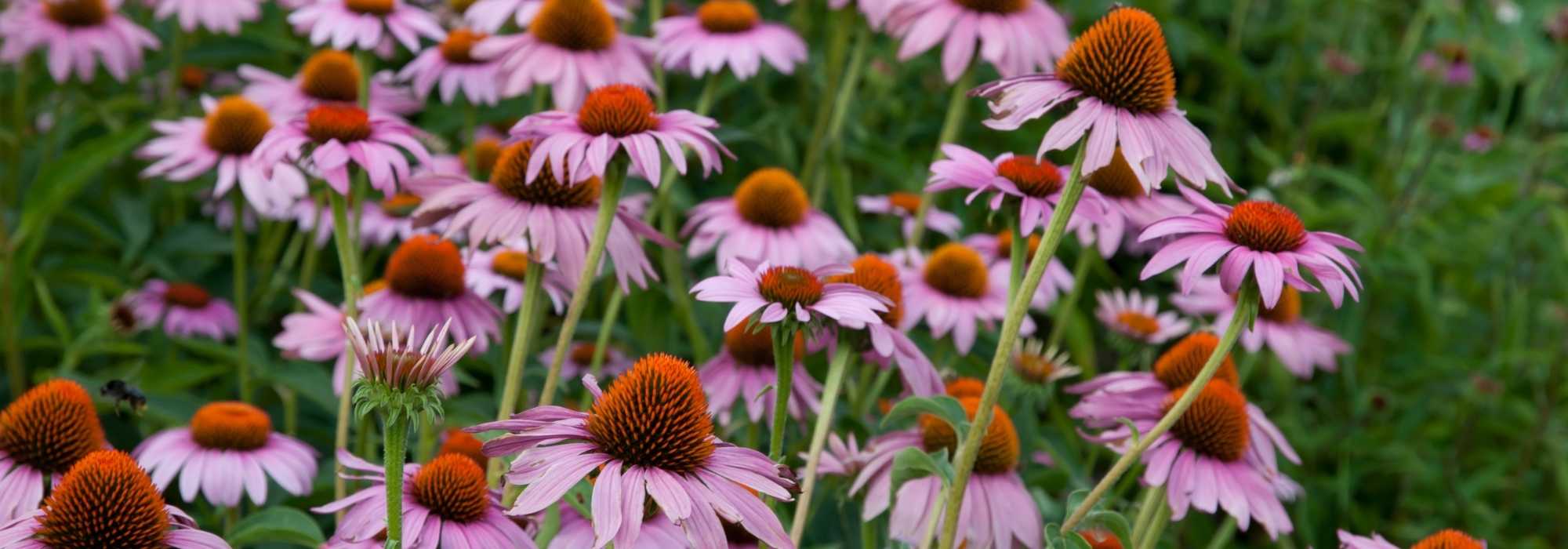
Choosing an echinacea
Our buying guide for selecting the most beautiful echinaceas
Contents
Recognisable among all with their prominent bristly cone-shaped centre and their pendulous petals as they bloom, echinaceas stand out as essential summer perennials for sunny gardens.
Often confused with Rudbeckias, with which they share many similarities, these perennials native to the vast meadows of the American West charm us with their long flowering period, warm colours, and a spirit that is both rustic and ornamental. Hardy and robust, drought-resistant, nectariferous, and easy to grow, they enliven borders throughout the summer season and beyond! There are over a hundred varieties, including the very popular Echinacea purpurea, as hybrid echinaceas have multiplied in recent years, offering gardeners a dizzying array of choices…
Want to plant some in your garden but unsure which to choose? We help you navigate the countless horticultural varieties based on their colour, shape, size, flowering precocity, and use.
 Not only are echinaceas beautiful, but they are also useful!
Not only are echinaceas beautiful, but they are also useful!
→ Learn more with our complete guide: Echinaceas, sowing, cultivation, and maintenance
According to their dimensions
Echinaceas are rightly considered medium to large perennials, as they range from 40 cm to over 1 m in height. They can be planted at the edge or in the foreground of borders for the shorter varieties, and as a focal point within generous flower beds for the taller ones that offer their stately appearance. Here are some of the most remarkable in their category:
• Small echinaceas (30 to 45 cm): Echinacea ‘Cranberry Cupcake’, and the golden yellow ‘Tweety’
• Medium echinaceas (between 50 and 80 cm): Echinacea angustifolia, Echinacea purpurea ‘Sunrise’, the orange ‘Tangerine Dream’, and ‘Fatal Attraction’
• Large echinaceas (between 80 cm and 1.20 m): Echinacea ‘Pretty Parasols’ and Echinacea ‘Fragrant Angels’ are supported on stems 90 cm high; Echinacea purpurea ‘Double Decker’, Echinacea purpurea ‘Green Twister’, Echinacea purpurea ‘Magnus’, and Echinacea purpurea ‘Razzmatazz’ grow to about 1 m, with ‘Leutchstern’ sometimes taller.

Echinacea purpurea ‘Cranberry Cupcake’, Echinacea angustifolia, Echinacea purpurea ‘Magnus’
Read also
Echinaceas : sowing, growing and careAccording to the colour of their flowers
On occasion, there is a tendency to confuse echinaceas with rudbeckias, even though they belong to different genera, and especially since the colour of their flowers was originally quite distinct: pinks and oranges for echinaceas, whites and yellows for rudbeckias. This is no longer entirely true with the introduction of numerous cultivars developed from purple coneflower, which has seen their colour palette expand considerably, from white to yellow, pinks and reds, as well as green, in addition to some bicoloured varieties. Echinaceas are particularly interesting for their colours that offer variations as they bloom: orange shifting to purple, pink intensifying, yellow turning to white in ‘Meringue’, for example.
Here are some of the most beautiful echinaceas in each colour:
• White Echinaceas: Echinacea purpurea ‘Alba’ with very white petals and a yellow-orange cone, Echinacea purpurea ‘Virgin’ with white ligules and a green cone, and Echinacea purpurea ‘Ferris Wheels’ with a subtle cream white and a contrasting copper-orange heart.
• Yellow Echinaceas: Echinacea paradoxa, the only species of the yellow type, and among hybrids: Echinacea purpurea ‘Summer Breeze’, beautifully dressed in golden yellow from heart to petals, and Echinacea purpurea ‘Sunrise’, with a very elegant straw yellow. → Also discover our selection of 5 yellow echinaceas.
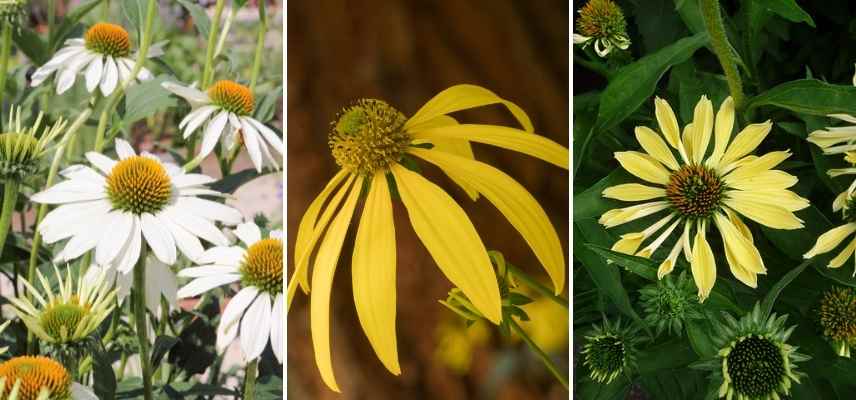
Echinacea purpurea ‘Alba’, Echinacea paradoxa and Echinacea purpurea ‘Sunrise’ (© FD Richards)
• Orange Echinaceas: the classic and vibrant ‘Tangerine Dream’ and ‘Pacific Summer’, orange tinged with coral and with a brown-orange cone. Read also 5 orange-flowered echinaceas to discover.
• Pink Echinaceas: the most common colour with the botanical type species Echinacea purpurea in a bright violet-pink, Echinacea purpurea ‘Pica Bella’ with fine bright pink petals, ‘Double Decker’ pink with an orange heart, and Echinacea purpurea ‘Kim’s Knee High’ with beautiful mauve-violet tones and an orange cone.
• Red Echinaceas: Echinacea purpurea ‘Eccentric’, one of the most flamboyant, Echinacea ‘Tomato Soup’ which lives up to its name, Echinacea ‘Hot Papaya’ in a stunning orange-red, and Echinacea ‘Hot Summer’, evolving from orange to red.

Echinacea purpurea ‘Pica Bella’ (© Cultivar 413) and Echinacea purpurea ‘Eccentric’ (© Leonora Enking)
• Green Echinaceas: Echinacea purpurea ‘Green Jewel’, a true gem with short light green ligules and a prominent dark green heart.

Echinacea purpurea ‘Tangerine Dream’ and ‘Green Jewel’
Discover other Echinacea - Coneflower
View all →Available in 1 sizes
Available in 3 sizes
Available in 3 sizes
Available in 2 sizes
Available in 1 sizes
Available in 2 sizes
Available in 3 sizes
Available in 0 sizes
Available in 1 sizes
According to the shape of their flowers
If they all offer a very distinctive and original appearance with their bristly cone and their large spreading capitulum resembling daisies, some echinaceas have much more trailing ligules than others, some are much finer, while others display unique double flowers. The heart is a more or less spiny cone, and sometimes forms a large pompon, giving a quirky look to the echinacea!
- Among the echinaceas with fine ligules are Echinacea paradoxa, Echinacea pallida including the delicate Echinacea pallida ‘Hula Dancer’, Echinacea purpurea ‘Pica Bella’, the bicolour ‘Green Envy’, and ‘Rocky Top’ with surprisingly upright ligules for an echinacea…
- The echinaceas with particularly trailing petals: ‘Hot Papaya’, the white ‘White Swan’,
- The echinaceas with double or unique flowers: ‘Razzmatazz’ with candy pink flowers, ‘Double Decker’ which forms a second “pompon” in its second year of flowering, ‘Vintage Wine’ with a large orange heart surrounded by short bright pink-wine ligules, Echinacea purpurea ‘Meringue’ with double flowers…
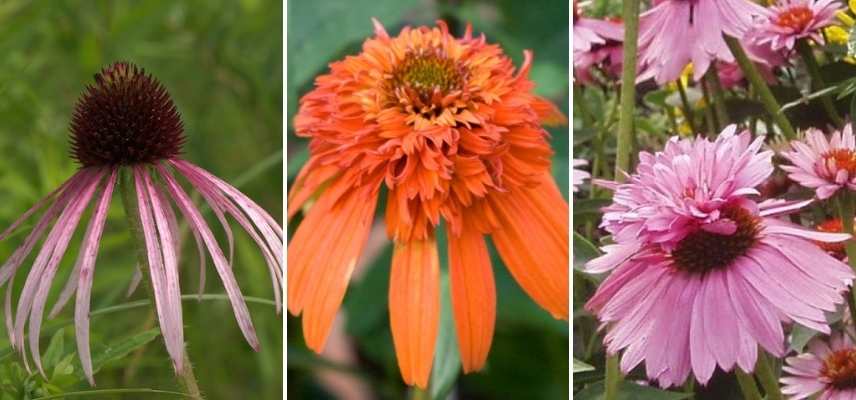
Echinacea pallida, Echinacea purpurea ‘Hot Papaya’ and Echinacea purpurea ‘Double Decker’
- The “pompon” cone: it is very large and pompon-shaped in the salmon echinacea ‘Irresistible’ and in Echinacea purpurea ‘Eccentric’, forms an astonishing double capitulum in ‘Razzmatazz’ and ‘Butterfly Kisses’.
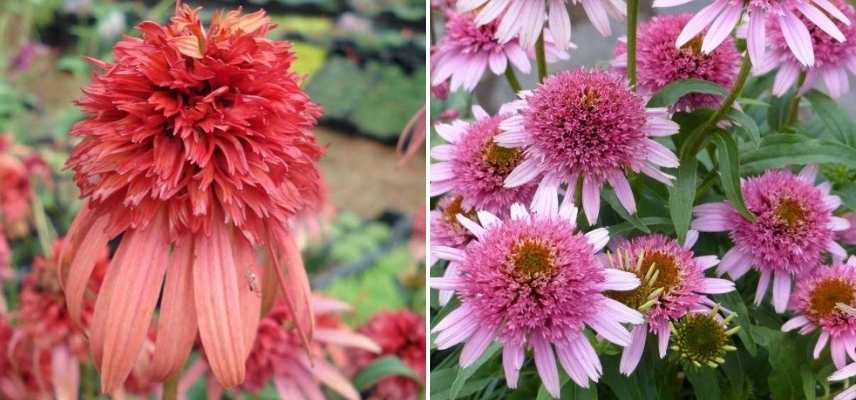
Echinacea purpurea ‘Irresistible’ and on the right the cultivar ‘Butterfly Kisses’
- The spiny domed cone: prominent in ‘Maui Sunshine’ and among the white echinaceas ‘Ferris Wheels’, ‘Green Edge’ and ‘Leuchtstern’, it is very beautiful in the species type Echinacea purpurea. The yellow echinacea ‘Lemon Drop’ also features a very attractive bristly cone.

Echinacea ‘Ferris Wheels’, purple echinacea, and Echinacea purpurea ‘White Swan’
Read also
How to plant Echinaceas?According to the size of their flowers
Appreciated for the beauty of their inflorescences, some varieties of echinacea are distinguished by their truly large heads, or by having a cone that is almost disproportionate, giving a true character to this American perennial.
- the largest heads: Echinacea purpurea ‘Primadonna’ with its very large flowers for the species, about 15 cm in diameter; Echinacea purpurea, the type species, has inflorescences nearly 10 cm in diameter, while Echinacea angustifolia (15 cm diam), and Echinacea purpurea ‘Alba’ reveals stunning large white flowers of about 8 cm.
- the large “disproportionate” cones: ‘Eccentric’, ‘Razzmatazz’, the superb golden yellow echinacea ‘Maui Sunshine’ with its orange cone.
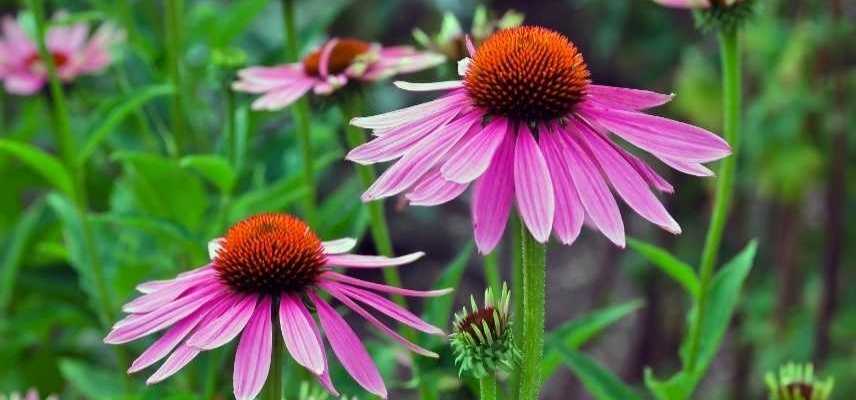
Echinacea angustifolia
According to their flowering season
Echinaceas generally flower from mid-July until September, sometimes even a bit longer, extending into October, which allows for one of the longest flowerings in the garden.
Some, however, are a bit earlier, starting their flowering from mid-June, such as ‘Harvest Moon’ with its large yellow flowers, ‘Fatal Attraction’ in a beautiful fuchsia pink, ‘Coupe Soleil’ with double cream-yellow flowers, or the Echinacea paradoxa, also yellow.
Others are truly late bloomers, flowering from August, such as the lovely Echinacea purpurea ‘Rocky Top’ in pink or the Echinacea purpurea ‘Sunrise’, straw yellow with an orange and green centre. Purple echinaceas can flower until October, just like the bicolour cultivar ‘Pretty Parasol’. To maximise their flowering period, remember to “clean” your beds by cutting back faded inflorescences.
According to their use
Echinaceas are among those plants that do not appreciate being moved. Therefore, it is essential to carefully consider their placement before planting them in the garden.
Highly wild, they thrive in naturalistic gardens alongside grasses and achilleas that evoke the scenes of vast spaces from which they originate. Echinaceas also lend themselves well to the establishment of more sophisticated borders due to their sculptural appearance: mixed-borders or large contemporary herbaceous beds where they are perfect as a backdrop for the taller varieties, for example.
You can also create beautiful mixed pots with, for instance, small Pennisetums or the dwarf ‘Lollipop’ Buenos Aires Verbena by using the lowest and most compact varieties of echinaceas.
Finally, echinaceas are excellent cut flowers: do not hesitate to plant or sow them in quantity in a cut flower garden and in large beds, so you can cut them and create beautiful bouquets that last well in a vase. Also, keep a few on their stems: they provide a lovely vertical and dark presence during the winter months and become resplendent again under the winter frost…

Echinaceas easily integrate into natural areas alongside soft grasses that dress their stiff stems, and in beds with late summer blooms like Asters
According to the soil
Echinaceas are not particularly troublesome and will accommodate practically all soils. However, they prefer rich and fertile soil, ideally moist, especially in the first few years to establish themselves, but they tolerate slightly dry and poor soils. They also require a sunny position to bloom continuously throughout the summer! Their only Achilles’ heel is actually waterlogged soil. They will adapt perfectly to a lack of watering after a few years.
It is worth noting that Echinaceas pallida particularly enjoy cool soils.
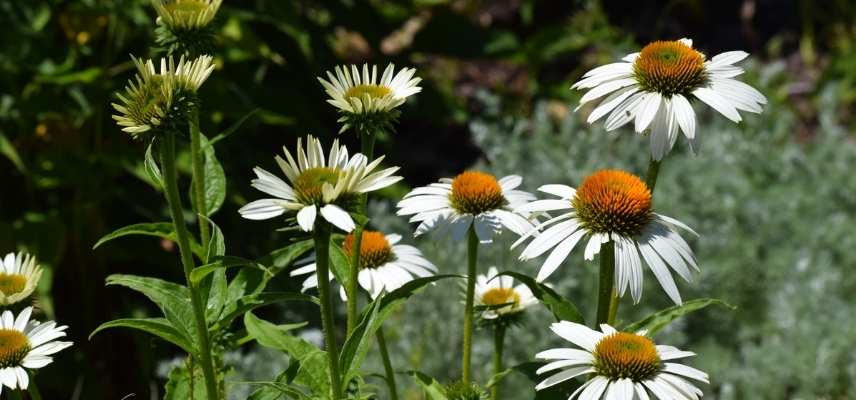
A sufficiently drained soil will be important for the successful establishment of your echinaceas
- Subscribe!
- Contents
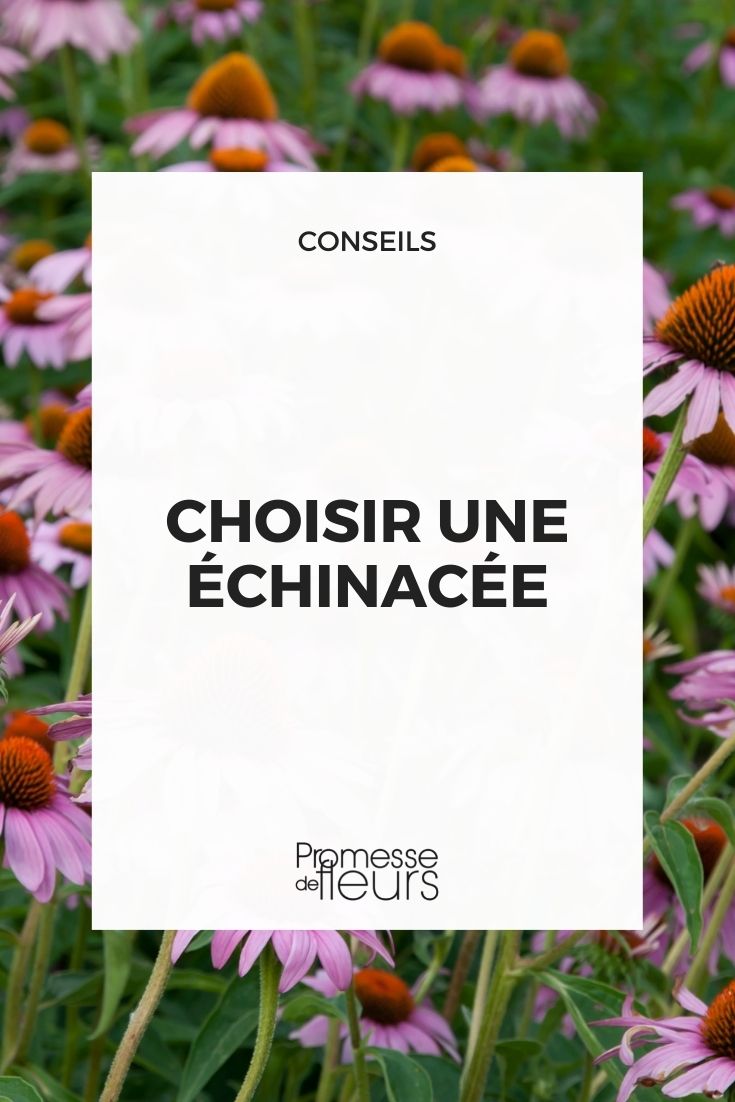

































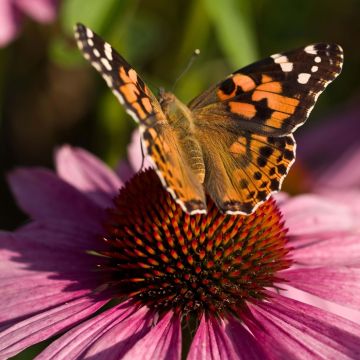

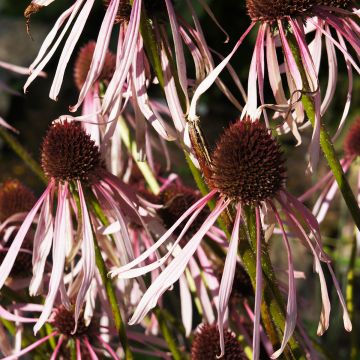
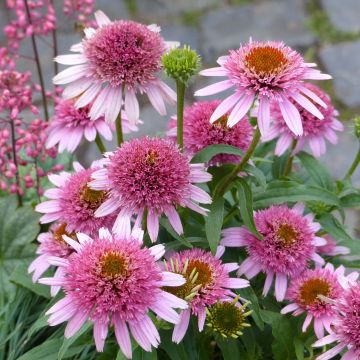
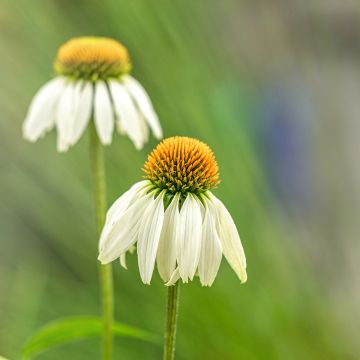
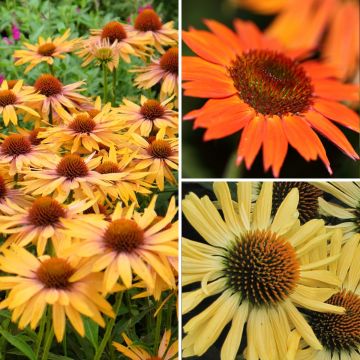


Comments